Cuminum cyminum
Cumin, Cuminum cyminum, is probably my all time favorite culinary spice.
Since I use it in just about everything that I cook, I am careful to make sure cumin seed is always in stock in my kitchen.
In fact, I love it so much, I decided to find out whether I can grow it in my own garden.
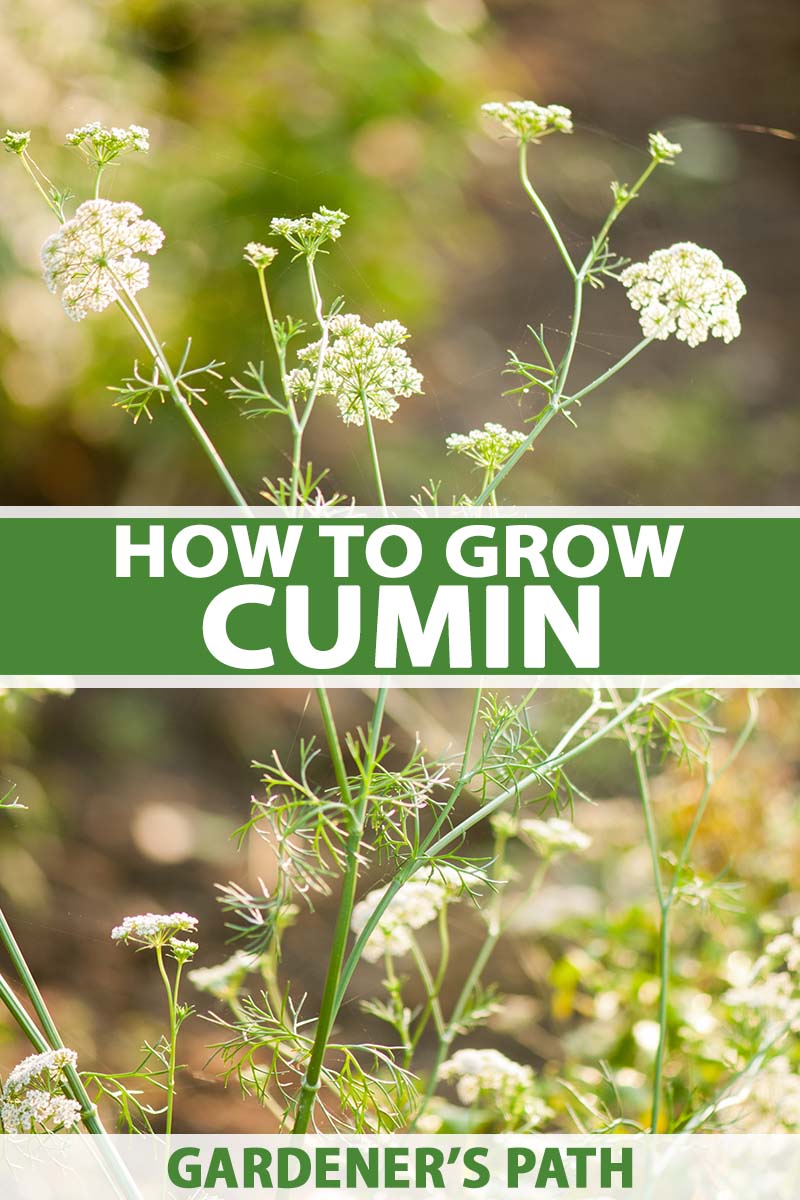
We link to vendors to help you find relevant products. If you buy from one of our links, we may earn a commission.
This herb may be a heat loving annual, but it turns out that with a few simple considerations in mind, growing it is very doable – even at my home in Vermont!
What You’ll Learn
What Is Cumin?
Cumin is a tender flowering annual in the parsley family, Apiaceae, that is grown for its seed. It is used in many different cuisines, and is one of the most popular spices in the world.
The seed has a warm, earthy, slightly bitter flavor that can enhance many different types of dishes. It is especially popular in Indian, Mediterranean, Middle Eastern, north African, and Mexican cuisines.

It is also especially popular in my kitchen!
The plant grows 1 to 2 feet tall and produces umbels of fragrant pink or white flowers that appear in midsummer, amidst feathery foliage similar to dill – which can be added to salads.
The flowers are followed by the characteristic fragrant seeds, which mature in about 120 days after planting.
In addition to its flavorful seeds, the flowers attract beneficial insects such as lacewings, predatory wasps, and ladybugs. Planting it in your garden near crops that tend to suffer from pest infestations can help keep pesky insects under control.
Cultivation and History
Native to the eastern Mediterranean, parts of the Middle East, and India, cumin is a very popular aromatic herb with a long history of use as a culinary spice and as a medicine.

Seeds were used in ancient Egypt as both a spice and a preservative in mummification. Ancient Greeks kept it in shakers on the table, similar to the way black pepper is commonly used today.
Also noted for its medicinal properties, in ancient Rome and Greece, it was commonly prescribed to aid women’s reproductive health.
It contains the active ingredient cuminaldehyde, a volatile oil with anti-inflammatory, antioxidant, and carminative properties.
Today, it is still used medicinally, particularly among practitioners of the Ayurvedic tradition. It is often taken as a tea, to help improve digestion, relieve bloating, and assist in the assimilation of fats into the body.

Since this herb is adaptable to a wide variety of climates, it is now grown in many different places, with the majority of the world’s supply produced in India.
Cumin Plant Propagation
As a Mediterranean crop, cumin is not frost tolerant and requires a long, hot growing season.
If you live in a colder climate, you can still grow it. But you must start your seeds indoors and transplant seedlings into the garden only after temperatures have warmed, with lows of at least 60°F.
To start from transplants, start seeds indoors about 4 to 8 weeks before your last expected frost date.
Germination takes about 14 days, and soaking seeds for about 8 hours prior to sowing will increase germination rates.
Because it does not transplant well, it is a good idea to use biodegradable pots for seed starting that can be planted directly into the garden.
You can also try starting seeds in soil blocks. This is a method of propagating seeds in homemade blocks of compressed soil, which eliminates the need for plastic pots and reduces the threat of transplant shock.
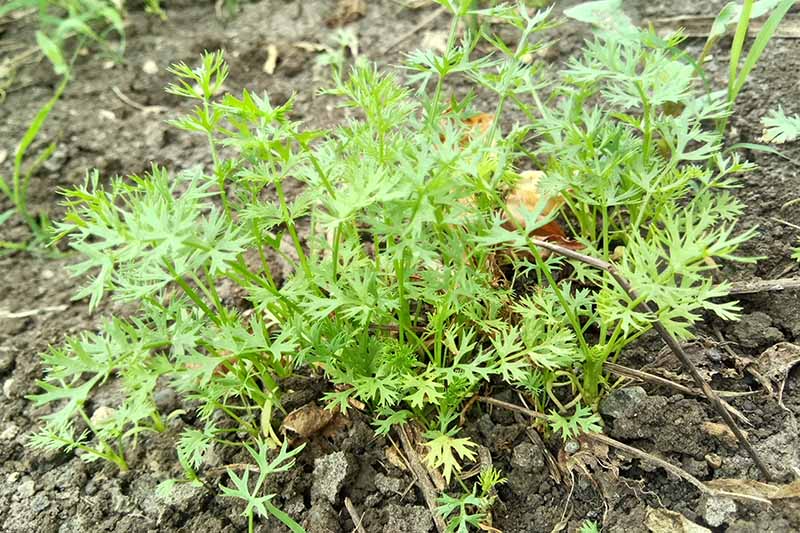
Sow seeds at about 1/4 inch deep in a basic potting mix and keep the soil moist, misting regularly until sprouts appear.
Transplant out into the garden when plants are a couple of inches tall, about 4 to 8 weeks after sowing the seeds, and when nighttime lows are steadily hold at at least 60°F.
In warmer climates where gardeners enjoy at least 4 months of frost-free weather, it is best to sow the seeds directly outdoors. This also eliminates the risk of transplant shock.
Direct sow seeds 1 to 2 weeks after your average last frost date, when nighttime temperatures won’t dip below 60°F, in a location that gets several hours of full sun a day.
Plant seeds 1/4 inch deep every 4 to 8 inches, spaced in rows arranged 18 inches apart.
You can also sow the seeds in clumps rather than rows, so these sometimes spindly plants can support each other as they grow.
Keep the soil moist until seeds germinate, about 1 to 2 weeks after sowing.
Keep in mind that each plant only produces a small number of seeds, so if you are growing cumin for its seed you might consider setting aside a fairly large area.
How to Grow Cumin Plants
Adaptable to USDA Hardiness Zones 5-10, cumin needs about 4 months of hot, sunny weather to mature and set seed.
Look for a spot in the garden that gets a long period of full sun each day. Cumin prefers well-drained sandy loam, though it will tolerate most nutrient-rich soils. It is adaptable to a wide pH range, with the ideal being between 7.0 and 7.5.
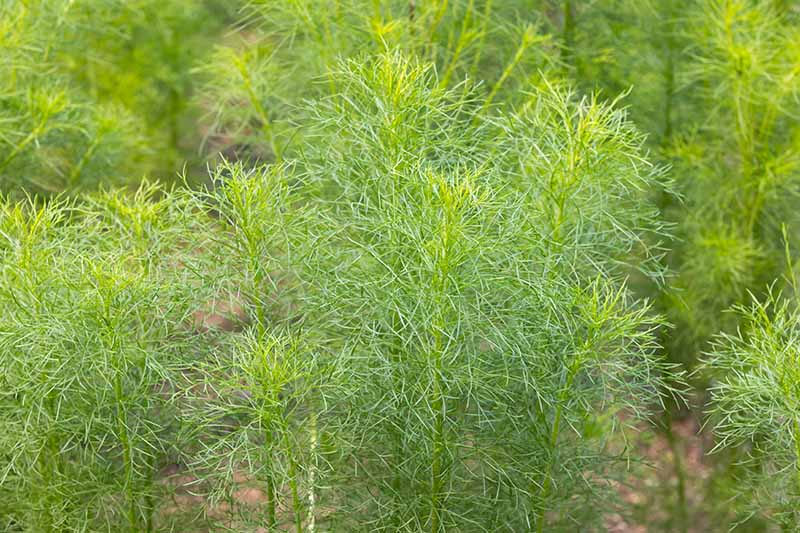
The good news is that once your plants are in the ground, maintenance is not too tricky!
Cumin is fairly drought tolerant, but it does benefit from some watering, especially during dry, hot periods. Water thoroughly before the soil completely dries out.
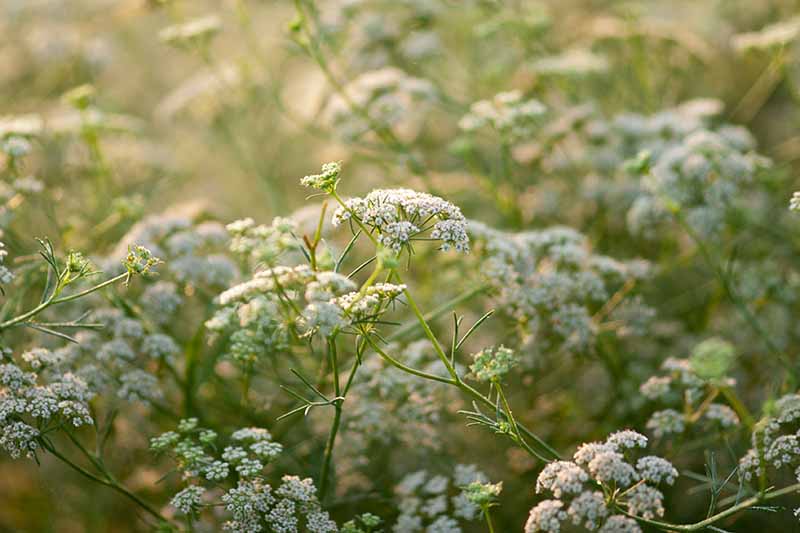
Overwatering can lead to root rot, so be cautious not to drench plants. In areas with long periods of dry heat, regular misting is a great way to keep plants moist without causing rotting.
Mulching with grass clippings, straw, or shredded leaves can also help to regulate soil moisture and prevent plants from becoming waterlogged, or drying out.
Growing Tips
- Start seeds indoors in colder climates, and plant out when nighttime temperatures rise above 60°F.
- Plant in full sun, ideally in well-draining sandy loam.
- Grow plants in clumps so they can support each other.
- Mist regularly to keep plants moist without overwatering.
- Mulch to regulate soil moisture.
Where to Buy Cumin Seeds
Though there is only one species in the Cuminum genus, a couple of other plants – Bunium bulbocastanum and Nigella sativa – are also sometimes referred to as “cumin.”
Though it may seem confusing initially, these other species are actually quite different from C. cyminum.
While some gardeners have had success germinating store bought seeds from the spice section of the grocery store, you never know how viable they will be.
Commercially produced spices are sometimes heat treated to kill off bacteria and insects, and you can’t be sure how fresh they are.
If you want to get started with growing your own cumin, you can find packets of seeds in a variety of sizes available from Eden Brothers Nursery.
You may also come across something called “black cumin,” which is botanically related to cumin, but has a distinctly different taste.
Mentioned above, t’s an herb also from the Apiaceae family, but it belongs to a different genus. B. bulbocastanum is edible, but it has a more harsh and bitter flavor than traditional brown cumin, and is not as commonly used.
Another plant, N. sativa, is also often referred to as black cumin or black seed.
This plant is completely unrelated, and from a different plant family altogether. It has a bitter, pungent flavor. Similarly to C. cyminum, it is used as a culinary spice in Indian and Middle Eastern cuisine.
If you are curious, you can find seeds at Eden Brothers.
Managing Pests and Disease
In addition to its use as a culinary herb, growing cumin has the added bonus of attracting beneficial insects to the garden.
Predatory wasps, lacewings, and ladybugs are among those that will be attracted to the fragrant flowers, and they will be happy to munch away at caterpillars and other insects on surrounding plants, keeping infestations in check.
Thus, in addition to growing it for culinary use, cumin makes a suitable trap plant for luring hungry insects away from your other crops.
Pests
Though it is a useful companion plant for natural pest control, cumin is also occasionally known to be susceptible to some pests and fungal diseases.
Aphids
These tiny pests attach themselves to foliage, puncturing holes in leaves and shoots and sucking out the sap, often causing the most damage to the younger parts of plants. Stunted growth, yellowing foliage, and curling leaves are all signs of an aphid infestation.
Aphids also secrete a sticky substance called “honeydew,” which encourages the growth of sooty mold.
You can spray plants with a strong blast of water from the hose to remove aphids. Just be sure to do this on a warm, sunny day to allow plants to dry out afterwards, especially if they are growing close together.
To treat more serious cases, you may apply an insecticidal soap. A solution of water mixed with a small amount of dish soap often does the trick. You can dilute 1 gallon of lukewarm water with 4 to 5 tablespoons of soap.
See our guide to managing aphids in your garden for more information.
Disease
A few fungal diseases, such as blight and powdery mildew, can cause problems for these plants. In general, keeping a vigilant eye on your plants and avoiding overwatering will help to keep these potential issues to a minimum.
Alternaria Blight
This fungus is common when warm, humid conditions are present during the flowering stage, preventing the seeds from fully maturing. It causes the seeds to shrivel up and blow away.
You can help prevent blight by weeding to improve air circulation between plants, using drip irrigation, and avoiding overwatering.
Powdery Mildew
This white, powdery fungus develops on the foliage of plants and can inhibit seed formation, or cause developing seeds to be small and discolored. If mildew appears, remove and dispose of affected leaves as soon as possible.
You can apply neem oil to prevent it from spreading.
Or, you can also try a homemade spray of baking soda, oil, and soap.
Combine one tablespoon of baking soda with one teaspoon of horticultural oil and one teaspoon of liquid dish soap in a gallon of water. Spray the mixture on plants as a preventative treatment, or in the early stages of the disease to prevent further spread.
Fusarium Wilt
Fusarium wilt is a fungal disease that causes wilting and discoloration of foliage.
It lives in both seeds and soil, and can spread through the soil via water as well as by wind. Harvesting the seed soon after it ripens will reduce the risk of contracting this infection.
Harvesting and Preserving Cumin Seeds
On average, plants will produce seeds about 120 days after planting, but this can vary and range from 100 to 150 days.
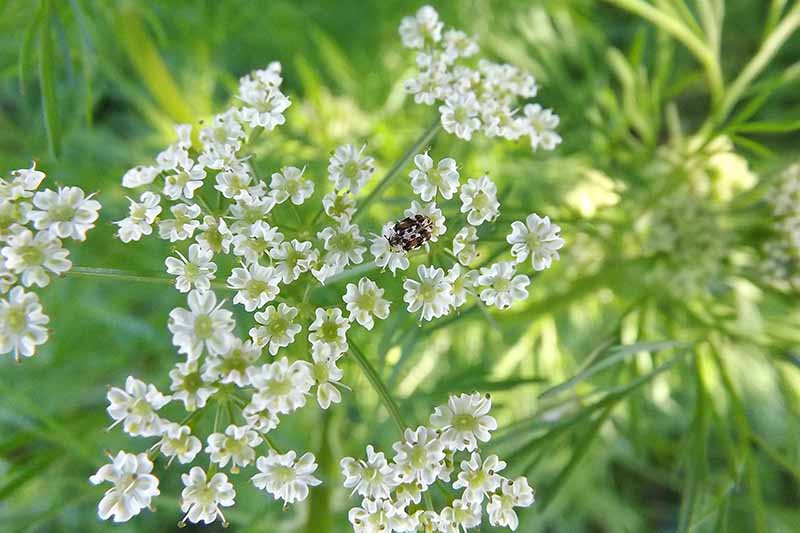
Keep a close eye on plants as the growing season progresses. If you miss the harvesting window, the seeds will dry out and scatter.
Plants won’t all necessarily ripen at the same time, so you may be harvesting a little bit every day over a period of time. Plan accordingly!
The seed is ready to harvest when the flowers have finished blooming and the clusters turn brown and dry out. This generally happens in the fall.

To harvest, cut the stems close to the ground and place the seed clusters in paper bags. Tie the stems together and hang the bags upside down in a warm, dry location to let the seeds dry out.
After about a week, or when the pods are completely dry, rub them between your fingers to encourage the seeds to drop out of the pods. You can also thresh the bag against a hard surface to release the seeds from the chaff.
Once the seeds are removed from the pods, sift them through a sieve or mesh cloth to remove any debris.
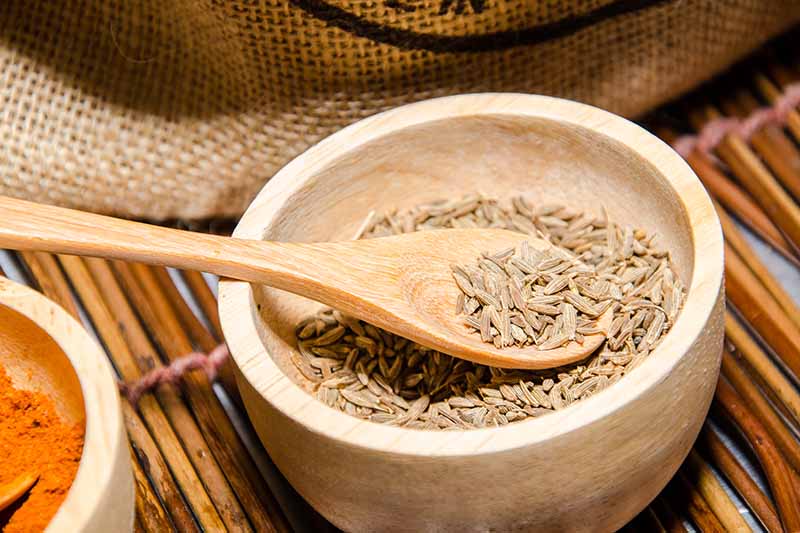
Store the seeds in a cool, dry, dark place.
I prefer to keep my spices in tightly lidded mason jars in a dark cupboard next to my oven for easy access when I’m cooking. You can also save a few to plant a new crop next year.
The seeds will keep for about 2 years if stored properly.
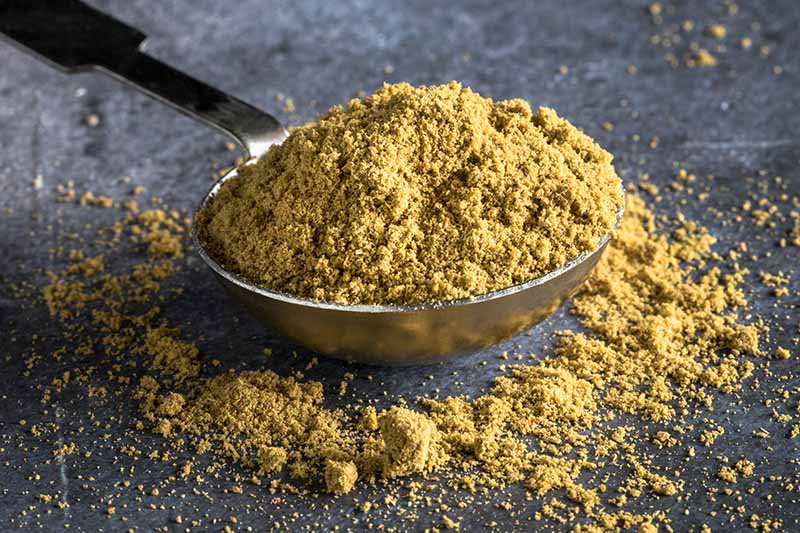
Seeds are commonly used whole or ground up, but wait to grind them until right before you are ready to use them. They will remain fresher and much more aromatic if you do! Dry roasted and ground cumin is one of my absolute favorite homegrown spices.
Recipes and Cooking Ideas
Cumin is a staple ingredient around the globe, and an important component of popular spice blends, such as chili powder and garam masala.
You will find it featured in all sorts of dishes, such as curries, hummus, falafel, couscous, meat stews, enchiladas, and fajitas.
Rice and beans spiced heavily with ground cumin is one of my go-to meals.
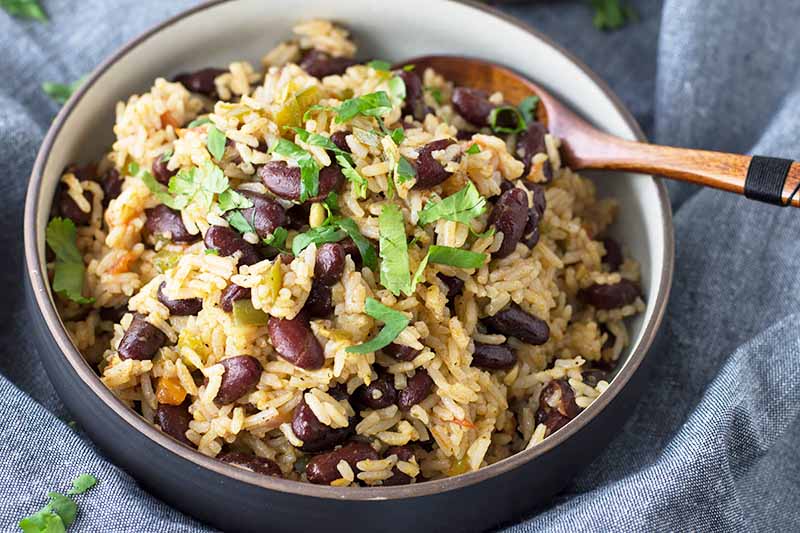
Great on its own, as a side, or wrapped up in a burrito, it’s hard to go wrong with this classic dish. Check out this recipe on our sister site Foodal to learn how to make the very best rice and beans.
Want to add a bit of character to your next salad dressing? You guessed it: it’s time to try throwing in some cumin!
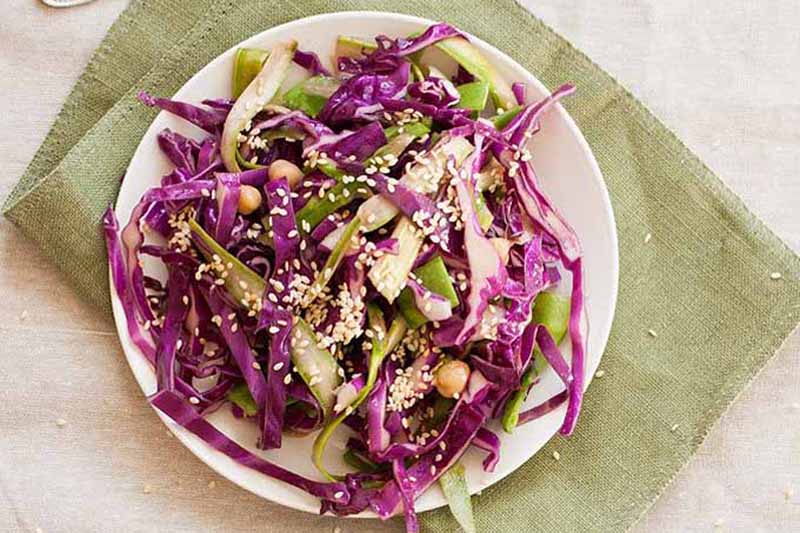
This cumin-sesame cabbage and asparagus slaw is sure to inspire, and the recipe is also on Foodal.
Or take your cumin creativity to the next level with white bean turkey chili, featured on Foodal.
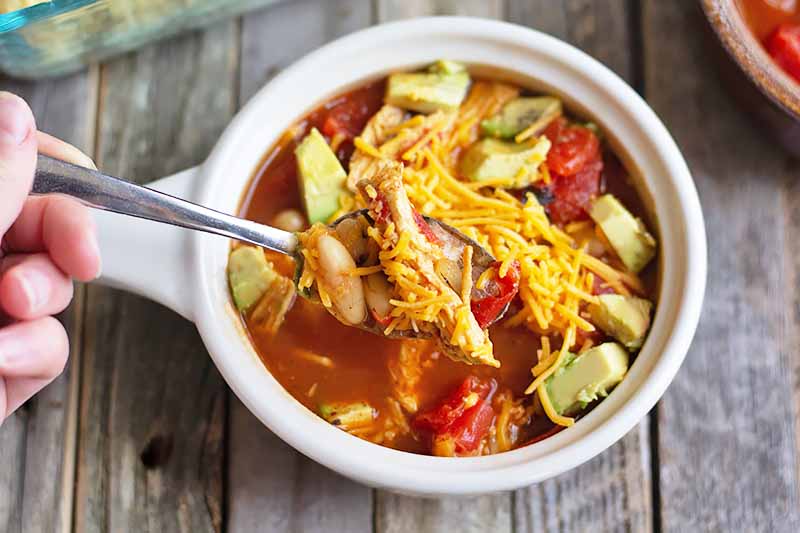
Each bite of this delicious, healthy twist on traditional chili will have you reaching for more!
Quick Reference Growing Guide
| Plant Type: | Flowering annual herb | Water Needs: | Low |
| Native to: | Mediterranean, Middle East | Maintenance: | Low |
| Hardiness (USDA Zone): | 5-10 | Soil Type: | Sandy loam |
| Season: | Summer | Soil pH: | 7-7.5 (neutral) |
| Exposure: | Full sun | Soil Drainage: | Well-draining |
| Time to Maturity: | 110-140 days | Tolerance: | Drought |
| Spacing: | 6-18 inches | Companion Planting: | Brassicas, beets, cucumbers, potatoes |
| Planting Depth: | 1/4 inch | Attracts: | Lacewings, ladybugs, predatory wasps |
| Height: | 1-2 feet | Family: | Apiaceae |
| Spread: | 2-6 inches | Genus: | Cuminum |
| Pests & Diseases: | Aphids; alternaria blight, powdery mildew, root rot, fusarium wilt | Species: | cyminum |
Just a Dash
No matter what kind of food you like to cook, cumin is one spice that’s always worth considering. All it takes is a dash of this aromatic seed to take a meal from boring and bland to exciting and flavorful!
Whether you grow a large patch for culinary use, or just a few plants to attract beneficial insects, you can’t go wrong with cumin!
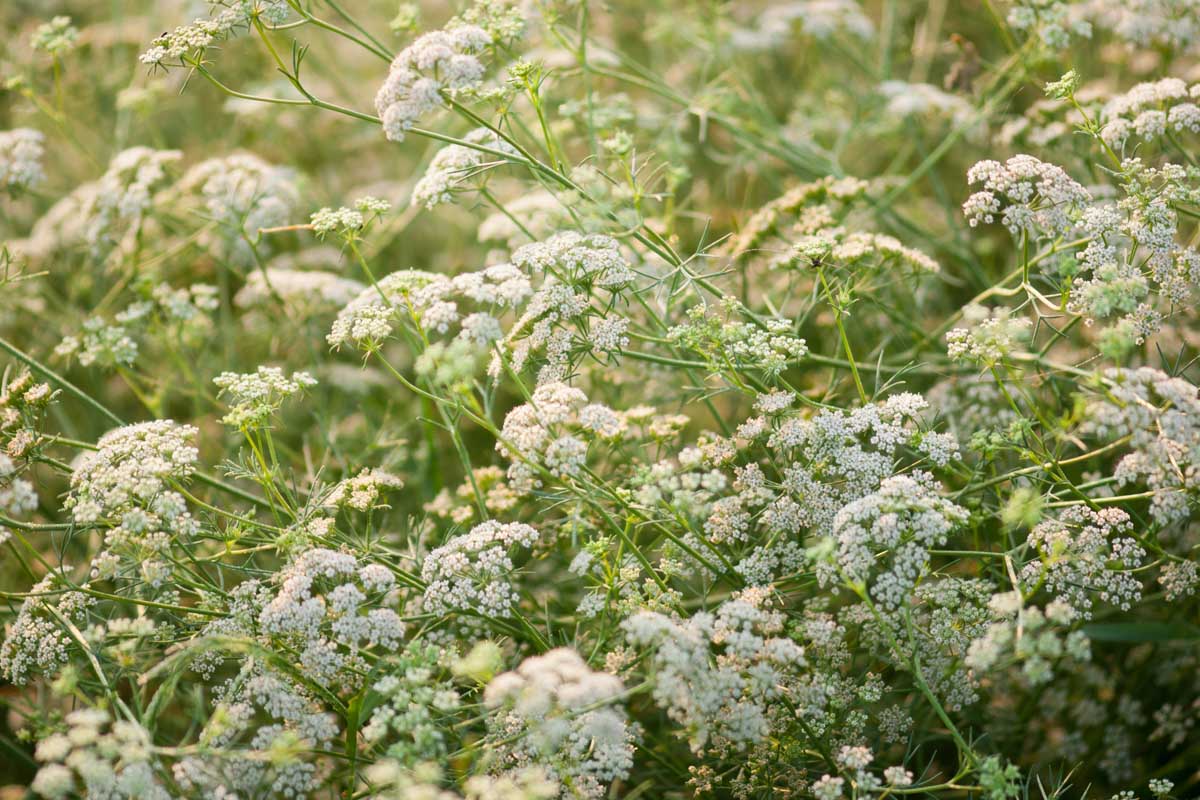
Do you enjoy this spice in your cooking, and have you had some success growing your own? Let us know in the comments!
If you’re thinking about adding to your herb garden, you’ll need these guides next:

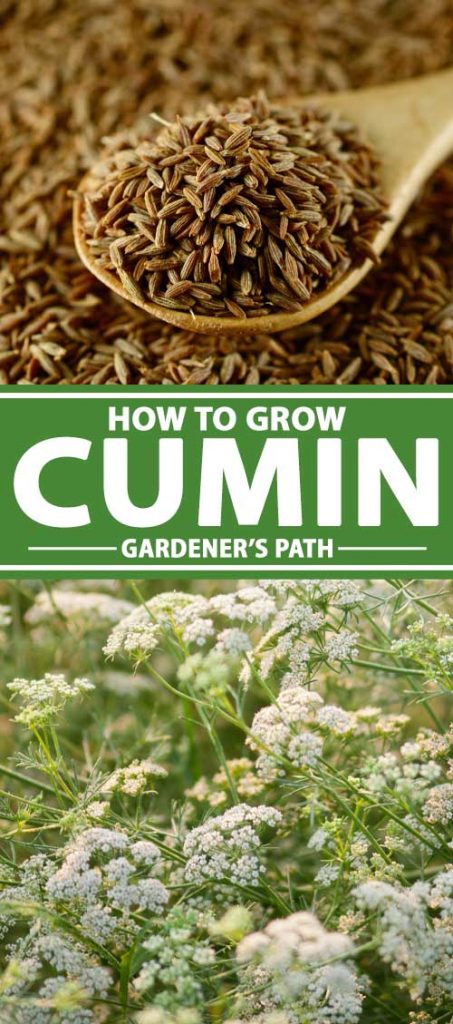
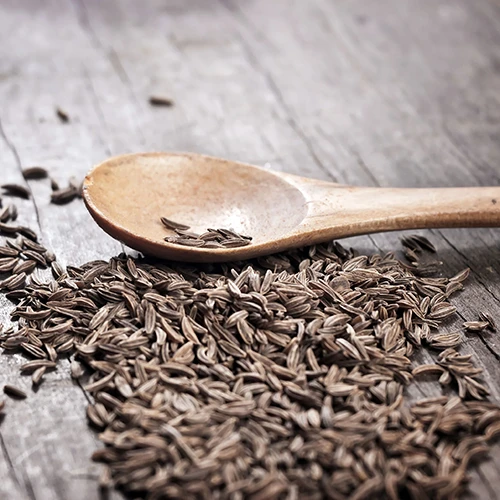
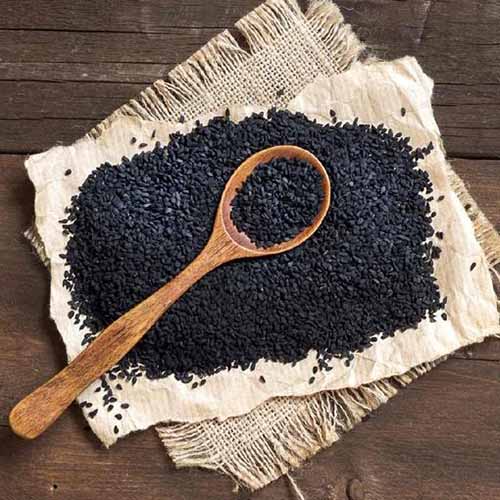
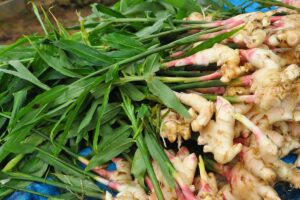
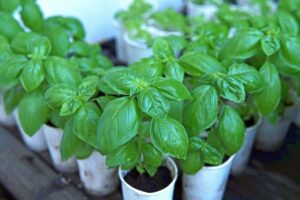
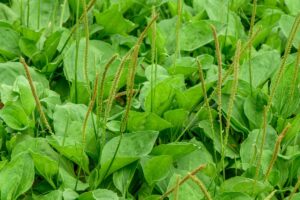
Just a small doubt.. Is the plant edible? I mean the leaves and flowers of cumin?
Hi Deepthi,
Glad you enjoyed the article. I believe the leaves are edible, though they are not commonly used. They have a slightly tangy flavor and can be added to salads.
This is really good information.. Enjoyed reading your article.. Thank you..
Do you roast the seed before use?
Hi Linda, Thank you for your question. Roasting is not necessary, but doing so will greatly intensify the herb’s aromatic flavor. To roast, place the cumin seeds in a dry pan on the stove on low heat. Cook gently for a few minutes, stirring often to prevent them from burning. Remove once the seeds have darkened and give off a delightful earthy scent. You can use toasted seeds whole or grind them first. Enjoy!
I enjoyed learning more about cumin in your article and believe I might be able to grow it in my yard! Thanks so much for your inspiring article!
Thanks for your feedback, I am so glad you enjoyed the article. Let us know how it goes!
it is a great article! You’d be a wonderful next door neighbor !